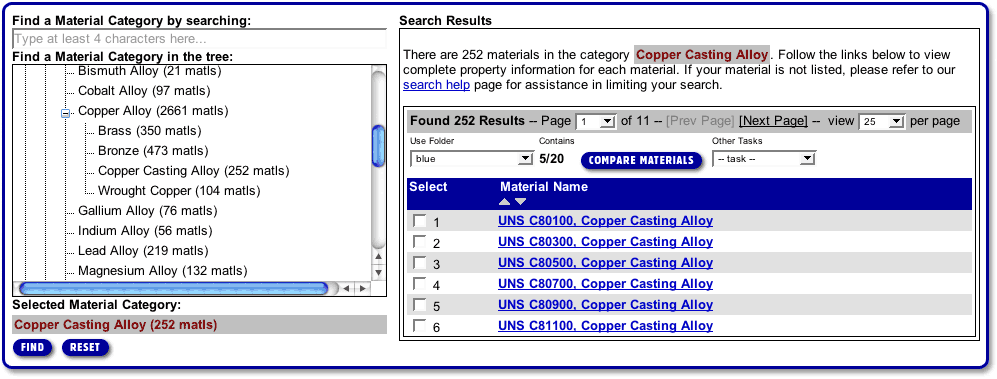Copper and Copper Alloys (Brass, Bronze)
MatWeb has data sheets for over 2500 copper alloys such as brass and bronze, including unique data
for different product forms and heat treatments. Once you navigate to specific data sheets, you will find the
properties you need for the copper alloys of your choice - such as the tensile strength and melting point of
SAE 40 Bronze or the density of
Leaded Muntz Metal, UNS C36500.
The fastest and surest way to find the database entries for all copper alloys is to follow the link to our
Search By Material Category and then select Metal --> Non-Ferrous --> Copper Alloy.
This feature is reproduced below:

(Click on the image to go there)
You can also choose "Copper Alloy" in conjunction with property values when you
Search By Property or use our Advanced Search. This will help you to naviagate
through our large collection to find the exact copper, brass, or bronze alloys that meet your property specifications.
Copper alloys can be difficult to find by a text-based search due to ambiguous common names and misnomers.
For example, the term "Silver-bearing tough pitch copper" is used for alloys with at least four different
composition ranges with different UNS numbers. When choosing text for our Quick Search, please
keep in mind that the MatWeb text-based search is sensitive to punctuation, spacing, and abbreviations; it will treat BeCu differently
than Be Cu. The UNS number is the most widely available search term but coppers can sometimes be found
in MatWeb by entering ASTM, CDA, CEN, and ISO designations. The UNS Number is often created from the Copper
Development Agency (CDA) number by adding a 'C' at the beginning and two zeroes at the end (ex: CDA 360 = UNS C36000).
No matter how you reach MatWeb's entries for specific copper, brass, or bronze entries, you will find
complete physical property data. The MatWeb staff has collected extensive data to bring you values for
properties such as composition, density, hardness, ultimate tensile strength, electrical resisitivity or conductivity, elastic modulus, etc.
For more information about copper, choose one of the following links:
